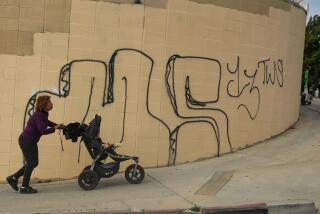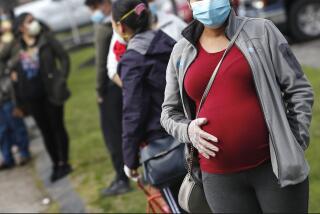Women Near Twin Towers Had Smaller Babies, Study Finds
Babies born to women who were pregnant and living near the World Trade Center when the Sept. 11 attacks occurred were smaller and had shorter gestation periods than those whose mothers lived elsewhere in New York, according to a study published Wednesday.
Physicians theorized that the newborns were affected in the womb by exposure to toxic dust and fumes wafting from ground zero, by their mothers’ psychological stress, or perhaps a combination of the two.
The study, paid for by privately funded charities and federal grants, confirmed the fears of community activists concerned that contaminants unleashed by the attack and cleanup had harmed people living nearby.
Researchers from Columbia University and Beth Israel Medical Center studied the full-term babies of 300 women who were pregnant on Sept. 11, 2001, and gave birth at three large hospitals in Lower Manhattan.
The children born to women living within a two-mile radius of ground zero “showed significant decrements in term birth weight and birth length” compared with infants born to women who lived farther away, according to the study published online in the journal Environmental Health Perspectives.
On average, the babies weighed 5.3 ounces less and measured one-third of an inch shorter.
In addition, women in the first trimester at the time delivered their babies earlier, by 3.6 days on average, than women who were in later stages of pregnancy -- regardless of how far they lived or worked from the World Trade Center. The babies also had slightly smaller head circumferences, a result of their shorter gestation.
Although the differences were not life-threatening and did not mean the newborns had medical problems, the scientists said, the study suggested that the terrorist attack had detrimental effects on fetuses. The researchers will continue to evaluate the same children to address whether there are any long-term health effects.
Dust and smoke from the collapsed World Trade Center contained elevated levels of contaminants known to cause genetic damage and disrupt the growth and neurological development of infants -- including lead, toxic hydrocarbons called PAHs, and PCBs, or polychlorinated biphenyls, which are found in old electrical transformers. Airborne contaminants typically have the greatest effect on a fetus because they are not cleansed from the system as readily as they would be in an adult.
The scientists, led by Sally Ann Lederman of the Columbia Center for Children’s Environmental Health, said they did not know exactly to which contaminants the women and babies had been exposed.
The exposure was “relatively brief” yet “substantial for those pregnant women who spent large portions of each day within two miles of the site during the month following the tragedy,” the scientists said. No effects were found in the babies of women who worked, but did not live, near the site.
Scientists in previous studies documented that a woman’s stress could cause preterm delivery and lower the birth weight of her baby. They also found links between pregnant women’s exposure to air pollution and their newborns’ size and length of gestation.
There also is evidence that stress may exacerbate the impact of toxic chemicals, which means Sept. 11 could have had a double-whammy effect.






